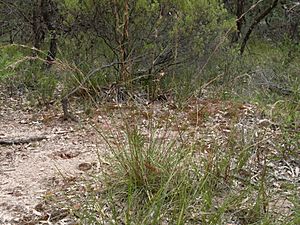Barbed wire grass facts for kids
Quick facts for kids Barbed wire grass |
|
|---|---|
 |
|
| Scientific classification | |
| Genus: |
Cymbopogon
|
| Species: |
refractus
|
| Synonyms | |
|
|
Cymbopogon refractus, commonly called barbed wire grass, is a type of grass that lives for many years (perennial). It grows naturally in Australia.
Contents
What is Barbed Wire Grass?
Barbed wire grass is a bunchgrass, which means it grows in a clump or tuft. It does not spread out using underground stems (called rhizomes) or above-ground stems (called stolons).
Plant Stems and Leaves
The main stems of the grass, known as culms, can grow up to 1 meter (about 3 feet) tall. These stems have branches that grow from their nodes, which are like joints on the stem. These nodes are usually purple and smooth.
The leaves of the plant grow from the base and along the stems. They are also smooth and do not have hairs. If you crush a leaf, it smells like lemon and ginger. This is a common smell for other grasses in the Cymbopogon family.
Flowers and Seeds
The plant's inflorescence is where its flowers are grouped together. This part grows on a stem that can be 10 to 45 centimeters (about 4 to 18 inches) long. It has small, almost hairless branches that bend downwards when they are mature. This bending makes the flower clusters look a bit like barbed wire, which is how the grass got its common name.
The tiny flowers, called spikelets, grow in pairs. One spikelet has a stalk, and the other does not. Barbed wire grass usually flowers from spring through autumn.
How Barbed Wire Grass Got Its Name
The scientific name for barbed wire grass is Cymbopogon refractus. It was first described by a scientist named R. Brown in 1810. At that time, he called it Andropogon refractus. Later, in 1921, another scientist named Camus moved it into the Cymbopogon group. This is how plants get their scientific names changed over time as scientists learn more about them.
Where Barbed Wire Grass Grows
You can find Cymbopogon refractus in many places across Australia. It grows well in poor soils, like those found along roadsides, in native pastures, and in woodlands and forests. It is common in Queensland, New South Wales, the Northern Territory, and Victoria.
This grass is very good at handling dry conditions, meaning it can survive droughts. However, it can be easily damaged by frost.

